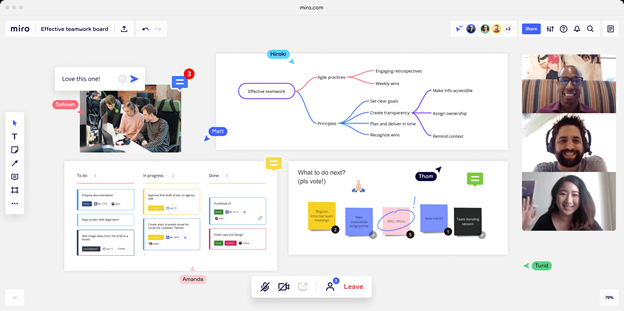When you see the tools we have today it is quite hard to imagine that people used to do things another way, with no technology involved. Imagine a room full of people looking through files, writing on notepads and chalkboards trying to keep up and compare it to how we do this today: from our couch, through Zoom and with amazing planning tools at our disposal.
Things evolved a lot in time and concept mapping is no stranger to that.
A concept map is a visual representation of information that can take the form of a chart, diagram, table, flowchart and pretty much any shape and form of organization you can imagine. For many years, concept maps were drawn by hand. Can you imagine how annoying that must have been?
Group concept mapping sessions would take place by counting a lot on post-it notes as they resemble boxes. People would simply gather in a room, discuss ideas and stick post-its on a board or even on the table to get a bird eye view of the entire project.

The introduction to computers opened the road to development of software programs that facilitate the usage of concept maps. For example, through the offline method if you wanted a co-worker to share his view on a certain idea, you would have to actually make him to come to your end of the table so that he can see the post-its clearly from your point of view. Today, you simply invite him to join your project through one simple click and he doesn't even have to move.
How did it all started, you're wondering? Well, back in 1987 Joseph D. Novak developed a research program at Cornell University in which his team looked for a way to follow and understand children's knowledge of science. During his studies he interviewed numerous children and learned that it was difficult to identify specific changes in their understanding of science concept by simply looking through the transcripts. The program was based on what David Ausubel learned about psychology: learning takes place by the assimilation of new concepts and propositions into already existing concepts held by the learner.

From here, a new idea emerged: to better represent children's conceptual understanding, their knowledge must be represented in the form of a concept map. This is the easiest, most clear method to show explicit relationships between concept maps using linking words and arranging ideas in a hierarchical form.
What today's concept maps look like and the benefits they bring
Today, if you have an idea and want to share it with your team it seems more like fun than work! For example, there's one particular concept map tool that will help you get that feeling right from the "sign-up for free" page: Miro! It is a collaborative and easy to use concept map tool that will allow you to generate new ideas, organize information and visualize complex concepts in the easiest, most intuitive and fun way possible. Working does not seem like working when you're actually enjoying what you're doing, right?
The Miro concept map tool offers the following benefits:
● Real-time collaboration: co-create and bring ideas to life with your team members, on the same board, at the same time, in real time;
● Amazing communication: built-in video, chat, mentions and comments;
● Presentation mode: use it to better explain your ideas to the team;
● Creative formatting options: let your creativity run wild and put your mind on the canvas for others to see;
● Integrate Miro with other tools such as Google Drive, Sketch and more;
● Benefit from an infinite canvas: add as many ideas and information as you want as the canvas will keep growing forever.
Besides being extremely useful, this tool also features a mind-blowing design. The entire platform is basically a form of digital art that will make you love it from the first click. The modern design, beautifully tailored color palette and intuitive usage will make you love using it and make work feel less like work.

Concept maps are not the only ones that changed with time. If years ago we used to only be able to discuss ideas in a meeting room at the office, nowadays we can simply open our computer and join a video call on an online platform.
If illustrators had to draw everything by hand on paper in order to bring it to life on a computer, nowadays they can use a graphic tablet to draw their ideas directly on the computer.
If writers had to write their articles on a typewriter to have it in print in the local newspaper, nowadays they use a laptop that they can take with them wherever they go and share their story online for the world to see in just a few minutes.
So, nowadays things are a lot easier. No matter what you want to do, you can do it on a computer from wherever you are and still get seen by the entire world in a just few clicks. The entire road from a simple idea to the final result can take place online in a more efficient way and it is very, very exciting! So, if you're looking for a way to organize your ideas and plans, a digital concept map is exactly what you need!
* This is a contributed article and this content does not necessarily represent the views of sciencetimes.com













![Venus Lost Water and Dried Out Due to Chemical Reaction HCO+ Dissociative Recombination [Study]](https://1721181113.rsc.cdn77.org/data/thumbs/full/53493/258/146/50/40/venus-lost-water-and-dried-out-due-to-chemical-reaction-hco-dissociative-recombination-study.jpeg)
